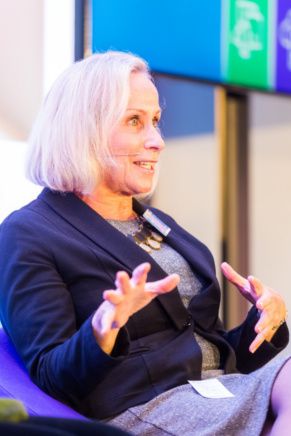
Empowering Health: Can avatars, virtual reality and robots help shape the future of nursing?
 I was delighted to be invited to speak at Microsoft’s Empowering Health event in Brussels, Belgium recently, which brought together some 200 thought-leaders from across the world to discuss health IT issues in a ‘Mobile First and Cloud First World’.
I was delighted to be invited to speak at Microsoft’s Empowering Health event in Brussels, Belgium recently, which brought together some 200 thought-leaders from across the world to discuss health IT issues in a ‘Mobile First and Cloud First World’.
I was looking forward to hearing about how some of the more progressive countries in Europe were utilizing technology to deliver more personal, productive and predictive health to its citizens so it was pleasing to hear examples from the Netherlands around patient portals and from Sweden where virtual care rooms are helping to deliver a more efficient healthcare system through patient self-diagnosis.
From these very real examples of today to discussions around the future of machine learning and robotics, the narratives were underpinned by the absolute need for clinical staff to have input into the technology solution they would be asked to use as early as possible.
Data: One size does not fit all
Some great statistics from Tom Lawry, Director of Worldwide Health Analytics, Microsoft, generated a real buzz in the room. Tom started his presentation by stating that ‘we spend a lot of money ONCE people are sick, while most money is spent on small numbers of people who are VERY sick.’ Clearly there are a lot of areas where technology is helping to move the needle from cure to prevention while all-in-one-day genome sequencing to personalized medicine is something we are working towards here at Intel as we look ahead to 2020.
I was interested to hear examples from across the world on how healthcare providers are dealing with increasingly large amounts of data. Within the European Union there are very different takes on what data is classed as secure and what is not. For providers and vendors, this requires a keen eye on the latest legislation, but it’s clear that it’s a case of one size does not necessarily fit all.
Digital education of nurses
 The breakout nursing session brought together a dedicated group of nurses with a real interest in how technology can, and will, help make nursing even better. We kicked off by discussing what level of digital education nurses have today, and what they need to equip them for the future. The consensus was that more needs to be done in helping nurses be prepared for the technology they’ll be asked to use, in essence making technology a core part of the nursing curriculum from day one.
The breakout nursing session brought together a dedicated group of nurses with a real interest in how technology can, and will, help make nursing even better. We kicked off by discussing what level of digital education nurses have today, and what they need to equip them for the future. The consensus was that more needs to be done in helping nurses be prepared for the technology they’ll be asked to use, in essence making technology a core part of the nursing curriculum from day one.
The move towards distributed care generated some fantastic thoughts on how technology can help nurses working in the community – read my recent blog for more thoughts on that. We all agreed that access to healthcare is changing, it has to if we are to meet the demands of an ageing population. For example, millennials don’t necessarily think that they need to see a medical practitioner in a hospital setting or a doctor’s surgery, they are happy to call a clinician on the phone or sit in a kiosk for a virtual consultation, the priority being quick and easy access.
Nurses actively championing technology
I was particularly impressed by a new app showcased by Odense University Hospital called Talk2Care – in short, it enables patients in ICU to ‘talk’ to nurses using an icon-based dashboard on a mobile device. This new way for patients to communicate, who would in some cases only be able to nod or shake their head, has been invaluable not only for nurses but the patient’s family too. What really pleased me was that nurses were actively championing this technology, encouraging patients to utilize it to help nurses deliver a better care experience.
We closed with thoughts on how taking care into the community was being revolutionized by technology. We’ve got some great examples of the role Intel is playing in the advance towards more distributed care, from the use of Intel IoT Gateways to help the elderly live more independent lives at home through to the KU Wellness car which empowers nurses to take advanced care into the community using mobile devices.
Virtual reality of nursing
After a short break we returned to the main auditorium where I was pleased to be on stage with nurses from across the world. The future of the workforce was discussed in some detail, particularly around how the nursing and the wider healthcare community will manage the anticipated future global shortage of nurses. Technology will go some way to alleviating this shortfall through improved workflows but I like to think in a more visionary way, perhaps we will see the use of avatars, virtual reality and (thinking of discussions earlier in the day) robots.
What’s clear is that nursing is changing in response to the move to distributed care, we need to skill not only nurses but other caregivers too, i.e. families, to make better use of the technology that is available today and tomorrow.




